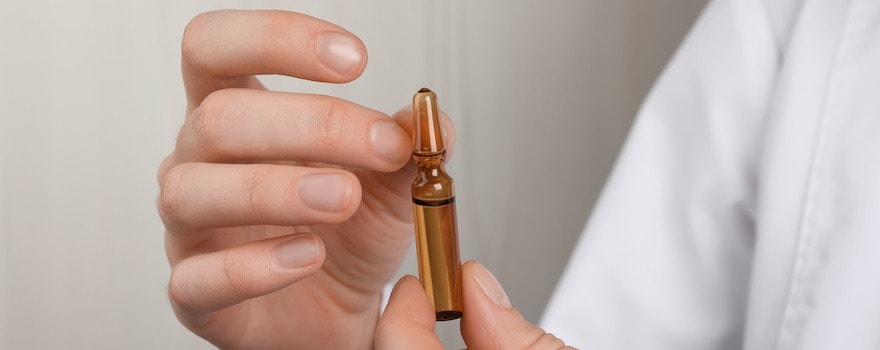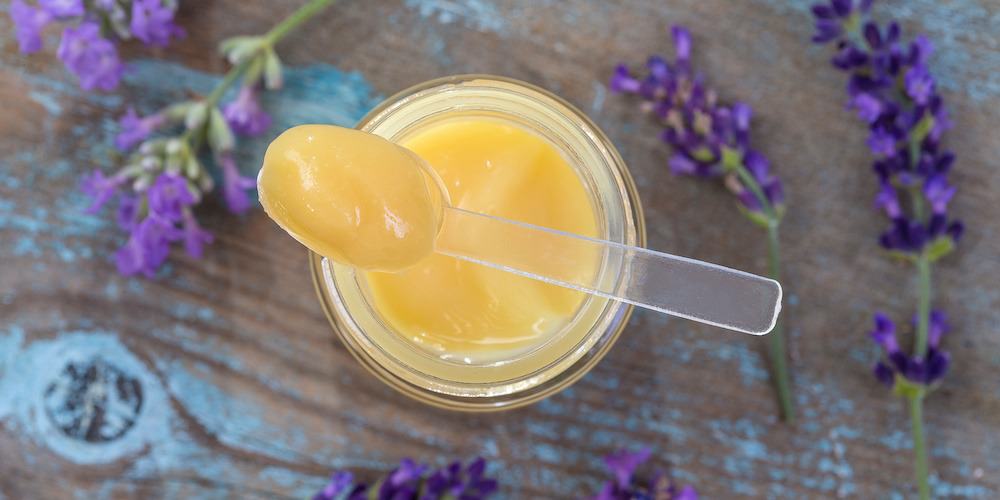What is royal jelly
The queen’s food
In the hive, royal jelly is secreted by the pharyngeal and mandibular glands of young worker bees.
This milky substance plays a central role in the hive, as it is the sole and exclusive food for larvae during the first three days of life, and for the queen throughout her existence.
The queen of a colony can live 5 to 6 years, while worker bees live about 45 days. Only the diet differs.
Bees produce only the amount necessary for their needs. There is no reserve like honey.
Royal jelly is a precious product with very limited production: a hive provides on average between 300 to 800 grams of royal jelly per year.
A unique composition
The unique composition of royal jelly explains its properties: it contains specific proteins such as royalisin, with antibacterial effects.
And especially a majority of Major Royal Jelly Proteins (MRJP), a key substance thought to be responsible for immunomodulatory activity and protection against oxidative stress, as stated in this study.
Royal jelly also contains carbohydrates (sugars), lipids, minerals (potassium, magnesium, phosphorus, zinc, iron, copper, manganese), and vitamins.
Such as vitamins A, C, D, E, and particularly B vitamins. These are essential for many metabolic reactions in the human body.
Finally, royal jelly contains a specific fatty acid, 10-HDA (10-hydroxy-2E-decenoic acid). It is known for its antibacterial, anti-inflammatory, and anti-cancer properties.
The concentration of 10-HDA is indicative of the quality and authenticity of royal jelly.

Benefits of royal jelly
The benefits traditionally attributed to royal jelly result from observations made between worker bees and the queen.
The lifespan and fertility of the queen have led scientists to question the exceptional virtues of royal jelly.
Since most studies are conducted on animals, it is currently difficult to translate these results to humans.
Effect on blood sugar
In a placebo-controlled study involving fifty patients with type 2 diabetes, taking 1000 mg of royal jelly 3 times a day for two months was associated with a greater reduction in glucose levels compared to non-supplemented patients.
A decrease in the concentration of “bad” cholesterol markers was also observed.
Another trial conducted over six months concluded that ingesting royal jelly could improve glucose tolerance.
Longevity and antioxidant power
Queen bees have a different longevity than other worker bees, even though they have the same genetic material.
Unlike worker bees, the queen consumes royal jelly her whole life: this substance has a powerful antioxidant action (fighting against cell aging) and also promotes cell growth.
A review of studies indicated that consuming royal jelly could play a role against oxidative stress.
Royal jelly contains notably antioxidant proteins, and 10-HDA, a fatty acid whose multiple pharmacological effects explain the longevity of queens, as noted in this article.
Finally, in a study on mice, preventive administration of royal jelly allowed for a reduction in tumor size. The organism’s antioxidant activity was increased.
Fertility
Royal jelly is traditionally used to promote fertility by increasing sperm mobility.
A study on animals concluded an increase in animal sperm survival rates, and another observed a stimulation of sex hormones in rats.
Anti-inflammatory and antibacterial action
Royal jelly is thought to have an anti-inflammatory function thanks to its main active ingredient: 10-HDA.
Thus, in this study conducted on human cancer cells, the production of molecules promoting inflammation was reduced after treatment with 10-HDA.
This compound also acts as an effective antibacterial on various bacteria, notably escherichia coli or staphylococcus aureus.
Effect on hormones
Royal jelly is a substance traditionally used by women due to its similarity with estrogens and its fatty acid content.
It may be beneficial for limiting menopause symptoms. Indeed, 10-HDA is thought to stimulate estrogen production: after 8 weeks of taking royal jelly for two months in 200 menopausal women, symptoms such as hot flashes and night sweats significantly decreased, as noted in this trial.
Another clinical trial conducted on women suffering from premenstrual syndrome concluded that royal jelly is effective in reducing PMS symptoms.
Finally, a study showed that administering royal jelly could increase pregnancy rates in sheep.
Note: Most research on royal jelly uses animal models. Additional studies are needed to confirm or refute these observations in humans.
The different forms of royal jelly
In ampoules
Fresh royal jelly has a distinctive taste, so manufacturers have developed forms to mask its flavor. Royal jelly ampoules are a commonly found form.
To be diluted in a glass of water, the ampoules allow for a sufficient concentration of royal jelly. A single daily intake is enough.
It is usually mixed with a citrus flavor to create a more pleasant taste.
Ampoules can contain many preservatives and chemicals, be cautious and read the labels.

In capsules or tablets
Convenient to use, the capsule form allows for proper preservation of royal jelly. Taking several capsules daily is often necessary.
This form can contain so-called lyophilized royal jelly, which offers optimal quality.
Manufacturers sometimes enrich capsules with other active substances for a synergistic effect: propolis, spirulina, acerola, ginseng, etc.
Ensure there is enough of a sufficient concentration of royal jelly per capsule for a significant effect.
In jars
This form is appreciated because it generally provides very nutritive and natural royal jelly.
Easy to use, it can be consumed pure with a spoon, or used as a spread on bread.
Purchasing criteria to consider
1. Fresh or lyophilized
Fresh royal jelly
It is most often found in jars/ It’s a pure form containing few or no additives. It comes from the hive cells and undergoes no chemical processing.
It thus provides the full range of vitamins and minerals contained in royal jelly.
Its flavor is sour and tangy, and its smell is strong: it won’t appeal to everyone but offers ideal nutritional quality.
Some can be stored at room temperature, but it is recommended to keep it chilled to maintain its properties.
Lyophilized royal jelly
It’s a dry powder form. It is primarily packaged in capsules or tablets, and sometimes also found in ampoules.
It allows for obtaining a precise amount of royal jelly. This form is not considered natural as it involves chemical processes to eliminate water.
The manufacturing steps can alter the properties of royal jelly: this substance is fragile and does not tolerate well the various freezing and drying processes necessary to obtain a powder.
Always prioritize quality laboratories that provide product analysis certificates.
2. Origin
Countries like China can produce up to 5 kilos per year per hive: the production is therefore industrial, and the properties of the final royal jelly may be altered.
More than 95% of royal jelly purchased in France is imported from Asia, and only 2% is French.
Since 2016, an international standard governs the production (quality, safety) requirements of royal jelly.
The ISO 12824 standard requires a minimum concentration of 1.4 grams of 10-HDA, the active compound of royal jelly, per 100 grams of fresh royal jelly, as well as an optimal protein level.
However, some unscrupulous manufacturers artificially enrich royal jelly to achieve this 10-HDA rate.
We recommend local and French producers and cooperatives.
In addition, this standard encompasses two types of royal jelly:
- Type 1 royal jelly without adding sugary food to the bees, ensuring bees are fed only pollen, honey, or nectar.
- Type 2 royal jelly means sugars or proteins have been added.
3. Quality of Royal Jelly
Turn to laboratories bearing the GRF: Gelée Royale Française label. This label was created by French beekeepers wishing to highlight local and small-scale royal jelly.
The GRF label supports the use of type 1 royal jelly and ensures respect for bees (no addition of antibiotics to their food), their environment, and manufacturing processes.
Traceability is known throughout the entire production chain, with a quality approach avoiding any risk of chemical or bacteriological contamination.
Thus, royal jelly remains in its raw state, without transformation and without added products.
4. Dosage and Usage
The dosage depends on the form used. A minimum average dose of 500 to 750 mg is recommended.
For fresh royal jelly, 1 or 2 grams per day is advised for a one or two months course.
Lyophilized royal jelly requires several daily doses, up to 5 capsules per day for some laboratories. Courses are somewhat longer, at least two months.
If you choose ampoules, 1 ampoule per day is enough if it is well dosed (and without additives). It is diluted in a glass of water or fruit juice. To be taken as a cure of a minimum of one month.
Regardless of the form used, I advise taking it on an empty stomach, so that your body assimilates the nutrients best.
5. Composition
Look for a 100% pure formula, of natural origin, without preservatives, without colorants, without added sugars.
Check that the product contains a minimum concentration of 1.4% of 10-HDA.
6. And Organic?
Organic royal jelly guarantees a product without pesticides or heavy metals, without antimicrobial treatments.
Organic royal jelly complies with a specific regulation: controlled bee feeding, use of organic flowers…
Checks are carried out annually at production sites. Organic certification is rare because it requires bees to forage only the certified organic fields.
Ultimately, organic royal jelly meets criteria similar to those of the GRF label.
It is better to buy non-organic royal jelly with a GRF label than organic-certified royal jelly from foreign sources.
Moreover, it will be cheaper than French organic royal jelly.
Risks, Contraindications, and Unwanted Effects
Allergies are possible with royal jelly, especially in asthmatic individuals and in cases of atopic eczema.
I advise starting a course with progressive doses, to observe the appearance of allergic symptoms (urticaria, edema, itching).
Special attention should be taken in cases of hormone-dependent cancer, and it is not recommended for pregnant and breastfeeding women.
To Summarize
To be sure to choose quality royal jelly, check:
- Fresh or Lyophilized: favor fresh royal jelly.
- Origin: choose local and French producers and cooperatives, type 1 royal jelly with a minimum concentration of 1.4 grams of 10-HDA.
- Quality of Royal Jelly: favor the GRF: Gelée Royale Française label.
- Dosage and use : fresh royal jelly 1 or 2 grams per day, freeze-dried up to 5 capsules per day, or 1 ampoule per day, and in all cases preferably on an empty stomach.
- Composition : 100% pure formula with a minimum concentration of 1.4% 10-HDA.
- Organic: It’s better to buy non-organic royal jelly with a GRF label than certified organic royal jelly from a foreign source.



